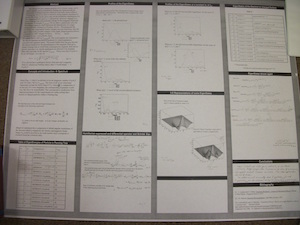Faculty Directory

- Adjunct Research Professor
- PHYS 101 for Pathway international students who enter WKU. The course includes an overview of logic, scientific method, the basics of problem solving, and introductory physics at the level ‘pre-algebra’.
- Have taught college physics and university physics at WKU. Accordingly am available as quickly needed for Phys 231 and Phys 255.
- Finite Element Method, other deterministic Methods, and Monte Carlo Computations for future courses in nuclear physics and math methods.
- Interest in finding the optimal meeting point between (traditional rigorous methods of math instruction) and (inclusion of ‘Smart’ symbolic software). I seek the optimal meeting point of where to start using in Mathematica as an inspiration and assistant to the student. I urge teachers of intense intermediate physics courses to be careful not to overwhelm novices to its level of abstraction and the temptation within such software to do everything for the student. The graphics in Mathematica can be a great learning tool to help the advanced student visualize the structure of a solution of a physics based equation. On the other hand, Matlab is popular among EE instructors and often of their students. Matlab encourages the introductory student to develop good programming habits and to be efficient in handling data. But Matlab, does not have the ability find analytical solutions with the effectiveness or elegance of Mathematica.
- Development of the Solid State PARES radioisotopic battery; improvements of the RECS radioisotopic battery; Further Development of various types of radioisotopic batteries. In the development of nuclear batteries, I have done theoretical work; original computations (of support, assessment, and design); and in-lab work which included radiation detection and constructing a rudimentary ‘battery’.
- Solving of the Maxwell Boltzmann Transport Equation for the pursuit of scholarly excellence in applied mathematics and for applications in nuclear and radiological engineering.
- Reviews, evaluations, and comparisons from benchmarks of known solutions for radiation transport to the predictions local radiation ‘flux’ which are procured from Monte Carlo simulations of scattering particles codes such as MCNP for hard photons and neutrons. Educational note: Scalar ‘flux’ has a somewhat different meaning here than the definition used for E-fields & B-fields.
- Reviews of classical field theories and semi-classical field theories which bridge quantum mechanical phenomena to classical phenomena
- Reactor Physics
- Shielding analysis and radiation dosimetry
- Nuclear Spectroscopy
- Understanding and improvements of nuclear states and nuclear decay – extending shell model and liquid drop model for decays, fissions, and spectra.
- Solving of partial differential equation semi-analytically and computationally
- Ph.D. from Oklahoma State University in Computational Physics and High Energy Physics
- Engineering Grad. from University of Missouri in Nuclear Engineering
- B.A. from Luther College in Physics and Mathematics
“A semi-analytical Matrix to extract keff and/or critical parameters of fissile Cores– as an Aid for deterministic Calculations of Multi-Group Neutronics”, published within the Conference Proceedings of the 2018 International Conference on Advances in Nuclear Power Progress;Publisher: ANS, (April, 2018).
“Analysis and MC Modelling of multiple Scattering of a Beam of Neutrons or Photons off of the Two Surfaces of a Broad Material Target as a Function of its Thickness”; https://arxiv.org/pdf/1712.08649; Arxiv publications board, (Dec. 2017).
“Analysis of the Scattering a Beam of Neutrons or Photons from broad Rectangular Targets - Modeling and Compact Benchmark Tools for quick estimates and MC Verifications”, Transactions of the American Nuclear Society, published in Vol. 108, (June 2014).
“Nuclear Batteries at Small and Large Scales using suitable Design Schemes”, Transactions of the American Nuclear Society, in Vol. 106, (June 2013).
“Comparison of the Performance Capabilities of Radioisotope Energy Conversion Systems, Betavoltaic Cells, and other Nuclear Batteries”, published within the Conference Proceedings of the 2006 International Conference on Advances in Nuclear Power Progress,pg. 2696-2706 (June, 2006).
“Transmission and secondary electron emission of 20-50 keV electrons through Aluminum Foils”, Journal of Physics D: Applied Physics40,pg. 284-287 (Jan. 2007).
Students: R Brown, K. A., B Thornberry, S Harper; “Analysis of Mass and Radius Sensitivity of a Crystalline Quark Star to a Strong Repulsive Equation of State”, Poster presentation at 83rd Annual Meeting of the APS Southeastern Section Volume 61, Number 19 (2016).
K. Andrew, E. Steinfelds, Nick Zolman (student); “The Mattig Expression for a d-dimensional Gauss Bonnet FRWL Cosmology”, Physics Archive - repository of arxiv publications under Cornel U. Library; https://arxiv.org/abs/1601.07037, (2016); K. Andrew, E. Steinfelds, Nick Zolman.
Sample Poster Presentations
(to spur Conversations in classic Field Theory)
In the SESAPS Conference of 2017, I presented a poster on the way a superconducting sphere generates Meisner surface currents of electricity in response to a magnetic dipole verses the response it would generate in response to a magnetic monopole in the same corresponding position with the same velocity. The hypothetical question is whether mag. Monopoles even exist in our solar system. A minority believe in them. This is a fun exercise in classical field theory, even if it is highly unlikely.
In the SESAPS conference of 2015, I presented a poster on quantum mechanical analysis of the Penning Trap to hold charged particles, a fulfillment of Landau & Lifshitz’s work for 2D-confinment. The famous text does not include the Hamiltonian for a complete Penning trap. The poster does address low energy level and eigenstates found for a quantum mechanical Penning trap. (Note to the advanced: Fermion characteristics of multiple electrons not considered in poster.)
A community of faculty, staff, and students engaged in better understanding the physical world.
Some of the links on this page may require additional software to view.



